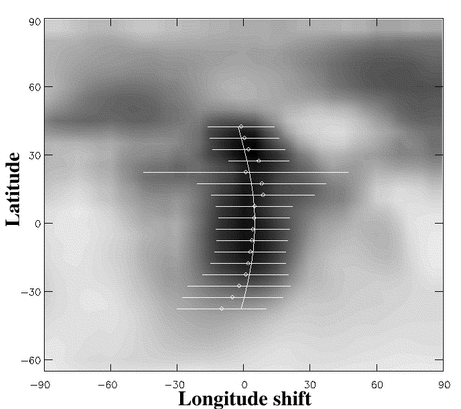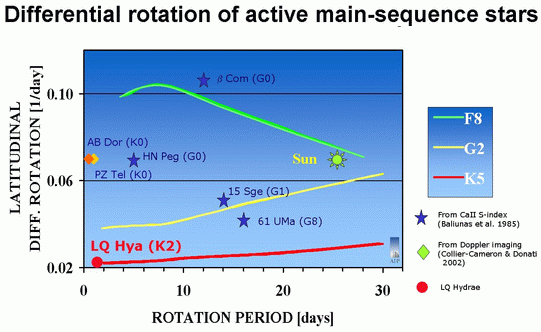|
Detection of weak solar-type differential rotation on a young star
We used time-dependent Doppler imaging to reconstruct the latitude
dependency of surface rotation on an active star. We found that the
equator is rotating faster than the poles with a lap time of ~280 days,
i.e. the time the equator needs to lap the pole by one full rotation. As
compared to the Sun, this implies a latitudinal shear that is roughly a
factor of 3 weaker than on the Sun and at a rotation rate roughly 15
times higher than the Sun's. This observation fits nicely the
predictions of Ruediger et al. (see below).

We reconstruct a time series of 28 surface temperature maps
(Doppler-images) of the spotted single K2-dwarf LQ Hya from 35
consecutive stellar rotations in Nov.-Dec. 1996. Two more maps are
obtained from data in late April and early May 2000, just two weeks
apart. All maps show spot activity preferably at low latitudes between
-20° and +50°, with a concentration in a band centered at around +30°,
and with only occasional evidence for a higher-latitude spot extension.
No trace of a polar spot is found at any of above epochs. Most of this
morphology can be reproduced by our flux-tube emergence model, except
for the equatorial activity where the strong Coriolis force due to the
rapid rotation always deflects flux tubes to higher latitudes. We also
present the detection of weak differential surface rotation from a
number of cross-correlation maps of the time-series images in late 1996.
A solar-type differential rotation law, i.e. the equator rotating faster
than the poles, with ΔΩ=+0.022 (lap time of ~280 days) is in agreement
with the data. Using the available photoelectric observations from 21
years we refine the rotation period to 1.60066±0.00013 days and find a
remarkable phase coherence over the course of 21 years, supporting the
recent finding of active longitudes by Berdyugina et al.. Furthermore,
our photometry shows a complex multi-cyclic long-term brightness
variability with three periods of 13.8±2.8 years, its harmonic 6.9±0.8
and 3.7±0.3 years, respectively. The 3.7-year period would be in good
agreement with the fundamental-mode oscillation period predicted by
Kitchatinov et al. from a distributed-dynamo model, but remains yet to
be confirmed.

Differential rotation is a key parameter controlling stellar activity.
The above figure compares observational and theoretical findings for the rotation
frequency variation on the stellar surface as a function of the rotation period and
spectral class. The symbols mark the observations for 8 active stars. The lines
show theoretical predictions of a series of papers by Rüdiger, Kitchatinov,
Küker, and Stix. The slopes of the theoretical lines change from K through G to F stars.
Rapidly rotating, young F stars are predicted to possess much stronger differential rotation
compared to later spectral classes.
More results of the Stellar Activity Group
Credits:
K.G. Strassmeier, M. Weber, T. Granzer, G. Rüdiger, AIP
Zs. Kovari, K. Olah, Konkoly Observatory
J.B. Rice, Brandon University
|



 last change 2003 September 29, R. Arlt
last change 2003 September 29, R. Arlt

